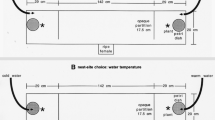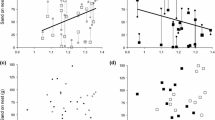Abstract
Brood guarding animals face many critical trade-offs. Sand goby males (Pomatoschistus minutus) build nests with larger openings during low oxygen conditions, presumably to enhance ventilation. However, this may make the nest easier for egg predators to detect and harder for guarding males to defend. Manipulating oxygen level and predator presence (a small crab) for small and large males, we found support for a parental trade-off between fanning and nest defense. An increased fanning activity resulted in less time for guarding. Small males and males in low oxygen showed a higher fanning expenditure than large males and males in high oxygen, but surprisingly, filial cannibalism did not differ between these groups. Males built larger nest openings in low than high oxygen. However, males in both high and low oxygen treatments reduced their nest opening size in the presence of a predator, again indicating an important trade-off between ventilation and nest defense.



Similar content being viewed by others
References
Andersson MB (1994) Sexual selection. Princeton University Press, Princeton, NJ
Bjelvenmark J, Forsgren E (2003) Effects of mate attraction and male–male competition on paternal care in a goby. Behaviour 140:55–69
Björklund M (1990) Nest failures in the scarlet rosenfinch Carpodacus erythrinus. Ibis 132:613–617
Clutton-Brock TH (1991) The evolution of parental care. Princeton University Press, Princeton, NJ
Coleman RM, Fisher RU (1991) Brood size, male fanning effort and the energetics of a nonshareable parental investment in bluegill sunfish, Lepomis–Macrochirus (Teleostei, Centrarchidae). Ethology 87:177–188
Downhower JF, Brown L (1980) Mate preferences of female mottled sculpins, Cottus bairdi. Anim Behav 28:728–734
Fonds M, Veldhuis C (1973) The oxygen consumption of four Pomatoschistus species (Pisces, Gobiidae) in relation to water temperature. J Sea Res 7:376–386
Fry FEJ (1971) The effect of environmental factors on the physiology of fish. In: Hoar WS, Randall DJ (eds) Fish physiology. Academic, London, pp 1–98
Gross MR (1980) Sexual selection and the evolution of reproductive strategies in sunfishes (Lepomis: Centrarchidae). PhD dissertation, University of Utah, Utah
Gustafson L, Sutherland WJ (1988) The costs of reproduction in the collared flycatcher Ficedula albicollis. Nature 335:813–865
Hale RE, St Mary CM, Lindström K (2003) Parental responses to changes in costs and benefits along an environmental gradient. Environ Biol Fishes 67:107–116
Hoelzer GA (1992) The ecology and evolution of partial-clutch cannibalism by paternal Cortez damselfish. Oikos 65:113–120
Jones JC, Reynolds JD (1999a) Costs of egg ventilation for male common gobies breeding in conditions of low dissolved oxygen. Anim Behav 57:181–188
Jones JC, Reynolds JD (1999b) Oxygen and the trade-off between egg ventilation and brood protection in the common goby. Behaviour 136:819–832
Keenleyside MHA (1981) Parental care patterns of fishes. Am Nat 117:1019–1022
Klug H, St. Mary CM (2005) Reproductive fitness consequences of filial cannibalism in the flagfish, Jordanella floridae. Anim Behav 70:685–691
Koskela E, Juutistenaho P, Mappes T, Oksanen TA (2000) Offspring defence in relation to litter size and age: experiment in the bank vole Clethrionomys glareolus. Evol Ecol 14:99–109
Kramer DL (1987) Dissolved oxygen and fish behavior. Environ Biol Fishes 18:81–92
Kume G, Yamaguchi A, Aoki I (2002) Dummy egg production by female cardinalfish to deceive cannibalistic males: oogenesis without vitellogenesis. Environ Biol Fishes 65:469–472
Kvarnemo C (1994) Temperature differentially affects male and female reproductive rates in the sand goby—consequences for operational sex-ratio. Proc R Soc Lond B 256:151–156
Kvarnemo C (1997) Food affects the potential reproductive output of sand goby females, but not of males. Behav Ecol 8:605–611
Kvarnemo C, Svensson O, Forsgren E (1998) Parental behaviour in relation to food availability in the common goby. Anim Behav 56:1285–1290
Lindström K (1998a) Energetic constraints on mating performance in the sand goby. Behav Ecol 9:297–300
Lindström K (1998b) Effects of costs and benefits of brood care on filial cannibalism in the sand goby. Behav Ecol Sociobiol 42:101–106
Lindström K, Sargent RC (1997) Food access, brood size and filial cannibalism in the fantail darter, Etheostoma flabellare. Behav Ecol Sociobiol 40:107–110
Lissåker M, Kvarnemo C, Svensson O (2003) Effects of a low oxygen environment on parental effort and filial cannibalism in the male sand goby, Pomatoschistus minutus. Behav Ecol 14:374–381
Magnhagen C (1993) Conflicting demands in gobies: when to eat, reproduce, and avoid predators. Mar Behav Physiol 23:79–90
Manica A (2004) Parental fish change their cannibalistic behaviour in response to the cost-to-benefit ratio of parental care. Anim Behav 67:1015–1021
Marconato A, Bisazza A, Fabris M (1993) The cost of parental care and egg cannibalism in the river bullhead, Cottus gobio L (Pisces, Cottidae). Behav Ecol Sociobiol 32:229–237
Neff BD (2003) Paternity and condition affect cannibalistic behavior in nest-tending bluegill sunfish. Behav Ecol Sociobiol 54:377–384
Östlund-Nilsson S (2002) Does paternity or parental investment determine the level of paternal care and does female choice explain egg stealing in the fifteen-spined stickleback? Behav Ecol 13:188–192
Perrin N (1995) Signalling, mating success and paternal investment in sticklebacks (Gasterosteus aculeatus): a theoretical model. Behaviour 132:1037–1057
Rangeley RW, Godin JGJ (1992) The effects of a trade-off between foraging and brood defense on parental behaviour in the convict cichlid fish, Cichlasoma nigrofasciatum. Behaviour 120:123–138
Reebs SG, Whorsikey FG, FitzGerald GJ (1984) Diel patterns of fanning activity, egg respiration, and the nocturnal behavior of male three-spined sticklebacks, Gasterosteus aculeatus L. (f. trachurus). Can J Zool 62:329–334
Rios-Cardenas O, Webster MS (2005) Paternity and paternal effort in the pumpkinseed sunfish. Behav Ecol 16:914–921
Rohwer S (1978) Parent cannibalism of offspring and egg raiding as a courtship strategy. Am Nat 112:429–440
Sargent RC (1985) Territoriality and reproductive trade-offs in the three-spined stickleback, Gasterosteus aculeatus. Behaviour 93:217–226
Sargent RC (1992) Ecology of filial cannibalism in fish: theoretical perspectives. In: Elgar MA, Crespi BJ (eds) Cannibalism: ecology and evolution among diverse taxa. Oxford University Press, New York, pp 38–62
Skolbekken R, Utne-Palm AC (2001) Parental investment of male two-spotted goby, Gobiusculus flavescens (Fabricius). J Exp Mar Biol Ecol 261:137–157
Smith C, Wootton RJ (1999) Parental energy expenditure of the male three-spined stickleback. J Fish Biol 54:1132–1136
St. Mary CM, Noureddine CG, Lindström K (2001) Environmental effects on male reproductive success and parental care in the Florida flagfish Jordanella floridae. Ethology 107:1035–1052
Stearns SC (1989) Trade-offs in life-history evolution. Funct Ecol 3:259–268
Suk HY, Choe JC (2002) The presence of eggs in the nest and female choice in common freshwater gobies (Rhinogobius brunneus). Behav Ecol Sociobiol 52:211–215
Swaisgood RR, Rowe MP, Owings DH (2003) Antipredator responses of California ground squirrels to rattlesnakes and rattling sounds: the roles of sex, reproductive parity, and offspring age in assessment and decision-making rules. Behav Ecol Sociobiol 55:22–31
Takegaki T, Nakazono A (1999) Responses of the egg-tending gobiid fish Valenciennea longipinnis to the fluctuation of dissolved oxygen in the burrow. Bull Mar Sci 65:815–823
Takeyama T, Okuda N, Yanagisawa Y (2002) Seasonal pattern of filial cannibalism by Apogon doederleini mouthbrooding males. J Fish Biol 61:633–644
Thomas LK, Manica A (2003) Filial cannibalism in an assasin bug. Anim Behav 66:205–210
Trivers RL (1972) Parental Investment and sexual selection. In: Campbell B (ed) Sexual selection and the descent of man 1871–1971. Heinemann, London, pp 136–179
Winkler DW, Wilkinson GS (1988) Parental effort in birds and mammals: theory and measurement. Oxf Surv Evol Biol 5:185–214
Vinyoles D, Côte IM, de Sostoa A (1999) Egg cannibalism in river blennies: the role of natural prey availability. J Fish Biol 55:1223–1232
Wootton RJ (1998) Ecology of teleost fishes. Kluwer, Dordrecht
Acknowledgements
We thank the staff at Klubban Biological Research Station, our field assistants Lotta Laurent, Daniel Simonsson, and Laila Fröberg. We also thank Kai Lindström, Ola Svensson, Sami Merilaita, Bertil Borg, Staffan Ulfstrand, and Ingrid Ahnesjö for advice and comments on the study and Wilhelm Leche’s Foundation, Stockholm Marine Sciences Association, Swedish Research Council, and Royal Swedish Academy of Sciences for financial support. We have followed the Guidelines for the Use of Animals in Research as well as the legal requirements of Sweden and the experimental set-up has, also, been approved by the Swedish Research Animals Ethical Committee.
Author information
Authors and Affiliations
Corresponding author
Additional information
Communicated by K. Lindström
Rights and permissions
About this article
Cite this article
Lissåker, M., Kvarnemo, C. Ventilation or nest defense—parental care trade-offs in a fish with male care. Behav Ecol Sociobiol 60, 864–873 (2006). https://doi.org/10.1007/s00265-006-0230-0
Received:
Revised:
Accepted:
Published:
Issue Date:
DOI: https://doi.org/10.1007/s00265-006-0230-0




